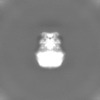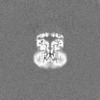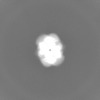[English] 日本語
 Yorodumi
Yorodumi- EMDB-48558: Desensitized state 1 of the GluA2-gamma2 complex prepared at 37 d... -
+ Open data
Open data
- Basic information
Basic information
| Entry |  | |||||||||
|---|---|---|---|---|---|---|---|---|---|---|
| Title | Desensitized state 1 of the GluA2-gamma2 complex prepared at 37 degrees C | |||||||||
 Map data Map data | GluA2-gamma2 complex 37 degree C desensitized state 1 LBD-TMD map, locally filtered | |||||||||
 Sample Sample |
| |||||||||
 Keywords Keywords | ligand gated ion channel / TRANSPORT PROTEIN | |||||||||
| Function / homology |  Function and homology information Function and homology informationspine synapse / dendritic spine neck / dendritic spine head / cellular response to amine stimulus / perisynaptic space / Activation of AMPA receptors / ligand-gated monoatomic cation channel activity / AMPA glutamate receptor activity / response to lithium ion / Trafficking of GluR2-containing AMPA receptors ...spine synapse / dendritic spine neck / dendritic spine head / cellular response to amine stimulus / perisynaptic space / Activation of AMPA receptors / ligand-gated monoatomic cation channel activity / AMPA glutamate receptor activity / response to lithium ion / Trafficking of GluR2-containing AMPA receptors / kainate selective glutamate receptor activity / cellular response to glycine / AMPA glutamate receptor complex / extracellularly glutamate-gated ion channel activity / immunoglobulin binding / asymmetric synapse / ionotropic glutamate receptor complex / conditioned place preference / regulation of receptor recycling / glutamate receptor binding / Unblocking of NMDA receptors, glutamate binding and activation / positive regulation of synaptic transmission / regulation of synaptic transmission, glutamatergic / response to fungicide / cytoskeletal protein binding / glutamate-gated receptor activity / regulation of long-term synaptic depression / cellular response to brain-derived neurotrophic factor stimulus / extracellular ligand-gated monoatomic ion channel activity / glutamate-gated calcium ion channel activity / presynaptic active zone membrane / somatodendritic compartment / dendrite membrane / ionotropic glutamate receptor binding / ligand-gated monoatomic ion channel activity involved in regulation of presynaptic membrane potential / ionotropic glutamate receptor signaling pathway / dendrite cytoplasm / synaptic membrane / dendritic shaft / SNARE binding / transmitter-gated monoatomic ion channel activity involved in regulation of postsynaptic membrane potential / synaptic transmission, glutamatergic / PDZ domain binding / protein tetramerization / establishment of protein localization / postsynaptic density membrane / cerebral cortex development / modulation of chemical synaptic transmission / receptor internalization / Schaffer collateral - CA1 synapse / terminal bouton / synaptic vesicle / synaptic vesicle membrane / signaling receptor activity / presynapse / amyloid-beta binding / growth cone / presynaptic membrane / scaffold protein binding / perikaryon / dendritic spine / chemical synaptic transmission / postsynaptic membrane / neuron projection / postsynaptic density / axon / external side of plasma membrane / neuronal cell body / synapse / dendrite / protein kinase binding / protein-containing complex binding / glutamatergic synapse / cell surface / endoplasmic reticulum / protein-containing complex / identical protein binding / membrane / plasma membrane Similarity search - Function | |||||||||
| Biological species |   | |||||||||
| Method | single particle reconstruction / cryo EM / Resolution: 4.17 Å | |||||||||
 Authors Authors | Kumar Mondal A / Twomey EC | |||||||||
| Funding support |  United States, 1 items United States, 1 items
| |||||||||
 Citation Citation |  Journal: Nature / Year: 2025 Journal: Nature / Year: 2025Title: Glutamate gating of AMPA-subtype iGluRs at physiological temperatures. Authors: Anish Kumar Mondal / Elisa Carrillo / Vasanthi Jayaraman / Edward C Twomey /  Abstract: Ionotropic glutamate receptors (iGluRs) are tetrameric ligand-gated ion channels that mediate most excitatory neurotransmission. iGluRs are gated by glutamate, where on glutamate binding, they open ...Ionotropic glutamate receptors (iGluRs) are tetrameric ligand-gated ion channels that mediate most excitatory neurotransmission. iGluRs are gated by glutamate, where on glutamate binding, they open their ion channels to enable cation influx into postsynaptic neurons, initiating signal transduction. The structural mechanics of how glutamate gating occurs in full-length iGluRs is not well understood. Here, using the α-amino-3-hydroxy-5-methyl-4-isoxazolepropionic acid subtype iGluR (AMPAR), we identify the glutamate-gating mechanism. AMPAR activation by glutamate is augmented at physiological temperatures. By preparing AMPARs for cryogenic-electron microscopy at these temperatures, we captured the glutamate-gating mechanism. Activation by glutamate initiates ion channel opening that involves all ion channel helices hinging away from the pore axis in a motif that is conserved across all iGluRs. Desensitization occurs when the local dimer pairs decouple and enables closure of the ion channel below through restoring the channel hinges and refolding the channel gate. Our findings define how glutamate gates iGluRs, provide foundations for therapeutic design and demonstrate how physiological temperatures can alter iGluR function. | |||||||||
| History |
|
- Structure visualization
Structure visualization
| Supplemental images |
|---|
- Downloads & links
Downloads & links
-EMDB archive
| Map data |  emd_48558.map.gz emd_48558.map.gz | 6.8 MB |  EMDB map data format EMDB map data format | |
|---|---|---|---|---|
| Header (meta data) |  emd-48558-v30.xml emd-48558-v30.xml emd-48558.xml emd-48558.xml | 19.4 KB 19.4 KB | Display Display |  EMDB header EMDB header |
| Images |  emd_48558.png emd_48558.png | 21.7 KB | ||
| Filedesc metadata |  emd-48558.cif.gz emd-48558.cif.gz | 5.9 KB | ||
| Others |  emd_48558_additional_1.map.gz emd_48558_additional_1.map.gz emd_48558_half_map_1.map.gz emd_48558_half_map_1.map.gz emd_48558_half_map_2.map.gz emd_48558_half_map_2.map.gz | 162 MB 301 MB 301 MB | ||
| Archive directory |  http://ftp.pdbj.org/pub/emdb/structures/EMD-48558 http://ftp.pdbj.org/pub/emdb/structures/EMD-48558 ftp://ftp.pdbj.org/pub/emdb/structures/EMD-48558 ftp://ftp.pdbj.org/pub/emdb/structures/EMD-48558 | HTTPS FTP |
-Validation report
| Summary document |  emd_48558_validation.pdf.gz emd_48558_validation.pdf.gz | 776.6 KB | Display |  EMDB validaton report EMDB validaton report |
|---|---|---|---|---|
| Full document |  emd_48558_full_validation.pdf.gz emd_48558_full_validation.pdf.gz | 776.2 KB | Display | |
| Data in XML |  emd_48558_validation.xml.gz emd_48558_validation.xml.gz | 16.8 KB | Display | |
| Data in CIF |  emd_48558_validation.cif.gz emd_48558_validation.cif.gz | 20.2 KB | Display | |
| Arichive directory |  https://ftp.pdbj.org/pub/emdb/validation_reports/EMD-48558 https://ftp.pdbj.org/pub/emdb/validation_reports/EMD-48558 ftp://ftp.pdbj.org/pub/emdb/validation_reports/EMD-48558 ftp://ftp.pdbj.org/pub/emdb/validation_reports/EMD-48558 | HTTPS FTP |
-Related structure data
| Related structure data | 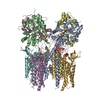 9mrlMC 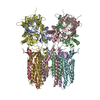 9dhpC 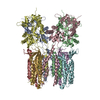 9dhqC 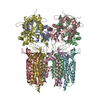 9dhrC 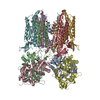 9dhsC 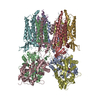 9dhtC 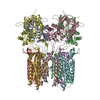 9mrkC 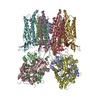 9mrmC 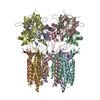 9mrnC M: atomic model generated by this map C: citing same article ( |
|---|---|
| Similar structure data | Similarity search - Function & homology  F&H Search F&H Search |
- Links
Links
| EMDB pages |  EMDB (EBI/PDBe) / EMDB (EBI/PDBe) /  EMDataResource EMDataResource |
|---|---|
| Related items in Molecule of the Month |
- Map
Map
| File |  Download / File: emd_48558.map.gz / Format: CCP4 / Size: 325 MB / Type: IMAGE STORED AS FLOATING POINT NUMBER (4 BYTES) Download / File: emd_48558.map.gz / Format: CCP4 / Size: 325 MB / Type: IMAGE STORED AS FLOATING POINT NUMBER (4 BYTES) | ||||||||||||||||||||||||||||||||||||
|---|---|---|---|---|---|---|---|---|---|---|---|---|---|---|---|---|---|---|---|---|---|---|---|---|---|---|---|---|---|---|---|---|---|---|---|---|---|
| Annotation | GluA2-gamma2 complex 37 degree C desensitized state 1 LBD-TMD map, locally filtered | ||||||||||||||||||||||||||||||||||||
| Projections & slices | Image control
Images are generated by Spider. | ||||||||||||||||||||||||||||||||||||
| Voxel size | X=Y=Z: 0.97 Å | ||||||||||||||||||||||||||||||||||||
| Density |
| ||||||||||||||||||||||||||||||||||||
| Symmetry | Space group: 1 | ||||||||||||||||||||||||||||||||||||
| Details | EMDB XML:
|
-Supplemental data
-Additional map: GluA2-gamma2 complex 37 degree C desensitized state 1...
| File | emd_48558_additional_1.map | ||||||||||||
|---|---|---|---|---|---|---|---|---|---|---|---|---|---|
| Annotation | GluA2-gamma2 complex 37 degree C desensitized state 1 LBD-TMD unsharpened map | ||||||||||||
| Projections & Slices |
| ||||||||||||
| Density Histograms |
-Half map: GluA2-gamma2 complex 37 degree C desensitized state 1...
| File | emd_48558_half_map_1.map | ||||||||||||
|---|---|---|---|---|---|---|---|---|---|---|---|---|---|
| Annotation | GluA2-gamma2 complex 37 degree C desensitized state 1 LBD-TMD map half A | ||||||||||||
| Projections & Slices |
| ||||||||||||
| Density Histograms |
-Half map: GluA2-gamma2 complex 37 degree C desensitized state 1...
| File | emd_48558_half_map_2.map | ||||||||||||
|---|---|---|---|---|---|---|---|---|---|---|---|---|---|
| Annotation | GluA2-gamma2 complex 37 degree C desensitized state 1 LBD-TMD map half B | ||||||||||||
| Projections & Slices |
| ||||||||||||
| Density Histograms |
- Sample components
Sample components
-Entire : glua2 tetramer bound to four molecules of TARPgamma2
| Entire | Name: glua2 tetramer bound to four molecules of TARPgamma2 |
|---|---|
| Components |
|
-Supramolecule #1: glua2 tetramer bound to four molecules of TARPgamma2
| Supramolecule | Name: glua2 tetramer bound to four molecules of TARPgamma2 / type: complex / ID: 1 / Parent: 0 / Macromolecule list: #1-#2 |
|---|
-Macromolecule #1: Isoform Flip of Glutamate receptor 2
| Macromolecule | Name: Isoform Flip of Glutamate receptor 2 / type: protein_or_peptide / ID: 1 / Number of copies: 4 / Enantiomer: LEVO |
|---|---|
| Source (natural) | Organism:  |
| Molecular weight | Theoretical: 46.074305 KDa |
| Recombinant expression | Organism:  Homo sapiens (human) Homo sapiens (human) |
| Sequence | String: EQKTVVVTTI LESPYVMMKK NHEMLEGNER YEGYCVDLAA EIAKHCGFKY KLTIVGDGKY GARDADTKIW NGMVGELVYG KADIAIAPL TITLVREEVI DFSKPFMSLG ISIMIKKPQK SKPGVFSFLD PLAYEIWMCI VFAYIGVSVV LFLVSRFSPY S ESTNEFGI ...String: EQKTVVVTTI LESPYVMMKK NHEMLEGNER YEGYCVDLAA EIAKHCGFKY KLTIVGDGKY GARDADTKIW NGMVGELVYG KADIAIAPL TITLVREEVI DFSKPFMSLG ISIMIKKPQK SKPGVFSFLD PLAYEIWMCI VFAYIGVSVV LFLVSRFSPY S ESTNEFGI FNSLWFSLGA FMQQGCDISP RSLSGRIVGG VWWFFTLIII SSYTANLAAF LTVERMVSPI ESAEDLSKQT EI AYGTLDS GSTKEFFRRS KIAVFDKMWT YMRSAEPSVF VRTTAEGVAR VRKSKGKYAY LLESTMNEYI EQRKPCDTMK VGG NLDSKG YGIATPKGSS LGTPVNLAVL KLSEQGVLDK LKNKWWYDKG ECGAKDSGSK EKTSALSLSN VAGVFYILVG GLGL AMLVA LIEFCYKSRA UniProtKB: Glutamate receptor 2 |
-Macromolecule #2: TARPgamma2
| Macromolecule | Name: TARPgamma2 / type: protein_or_peptide / ID: 2 / Number of copies: 4 / Enantiomer: LEVO |
|---|---|
| Source (natural) | Organism:  |
| Molecular weight | Theoretical: 18.984268 KDa |
| Recombinant expression | Organism:  Homo sapiens (human) Homo sapiens (human) |
| Sequence | String: RGVQMLLTTV GAFAAFSLMT IAVGTDYWLY SRGVCKEVMT HSGLWRTCCL EGNFKGLCKQ IDHFAEYFLR AVRASSIFPI LSVILLFMG GLCIAASEFY KTRHNIILSA GIFFVSAGLS NIIGIIVYIS ANAGNSYSYG WSFYFGALSF IIAEMVGVLA V HMFIDRHK QLTG |
-Macromolecule #3: GLUTAMIC ACID
| Macromolecule | Name: GLUTAMIC ACID / type: ligand / ID: 3 / Number of copies: 4 / Formula: GLU |
|---|---|
| Molecular weight | Theoretical: 147.129 Da |
| Chemical component information | 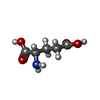 ChemComp-GLU: |
-Experimental details
-Structure determination
| Method | cryo EM |
|---|---|
 Processing Processing | single particle reconstruction |
| Aggregation state | particle |
- Sample preparation
Sample preparation
| Buffer | pH: 8 |
|---|---|
| Vitrification | Cryogen name: ETHANE |
- Electron microscopy
Electron microscopy
| Microscope | TFS KRIOS |
|---|---|
| Image recording | Film or detector model: FEI FALCON IV (4k x 4k) / Average electron dose: 40.0 e/Å2 |
| Electron beam | Acceleration voltage: 300 kV / Electron source:  FIELD EMISSION GUN FIELD EMISSION GUN |
| Electron optics | Illumination mode: FLOOD BEAM / Imaging mode: BRIGHT FIELD / Nominal defocus max: 2.5 µm / Nominal defocus min: 1.0 µm |
| Experimental equipment |  Model: Titan Krios / Image courtesy: FEI Company |
 Movie
Movie Controller
Controller











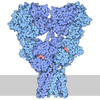
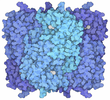
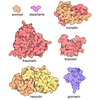


 Z (Sec.)
Z (Sec.) Y (Row.)
Y (Row.) X (Col.)
X (Col.)





























